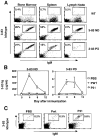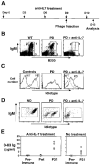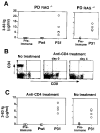T cell-independent rescue of B lymphocytes from peripheral immune tolerance
- PMID: 10741972
- PMCID: PMC3786169
- DOI: 10.1126/science.287.5462.2501
T cell-independent rescue of B lymphocytes from peripheral immune tolerance
Abstract
Autoimmunity arises when immune tolerance to specific self-antigens is broken. The mechanisms leading to such a failure remain poorly understood. One hypothesis proposes that infectious agents or antigens can break B or T lymphocyte self-tolerance by expressing epitopes that mimic self. Using a transgenic immunoglobulin model, we show that challenge with self-mimicking foreign antigen rescues B cells from peripheral tolerance independent of T cell help, resulting in the accumulation of self-reactive cells in the lymph nodes and secretion of immunoglobulins that bind to a liver-expressed self-antigen. Therefore, our studies reveal a potentially important mechanism by which B lymphocytes can escape self-tolerance.
Figures




Comment on
-
Assessing the mechanisms that give rise to autoimmunity.Science. 2000 Oct 6;290(5489):11. doi: 10.1126/science.290.5489.11a. Science. 2000. PMID: 11183137 No abstract available.
References
-
- Vyse TJ, Todd JA. Cell. 1996;85:311. - PubMed
-
- Oldstone MBA. Cell. 1987;50:819. - PubMed
- Wucherpfennig KW, Strominger JL. Cell. 1995;80:695. - PMC - PubMed
- Miller SD, et al. Nature Med. 1997;3:1133. - PubMed
- Lehmann PV, Forsthuber T, Miller A, Sercarz EE. Nature. 1992;358:155. - PubMed
- McRae BL, Vanderlugt CL, Dal CM, Miller SD. J Exp Med. 1995;182:75. - PMC - PubMed
- Tough DF, Sprent J. Immunol Rev. 1996;150:129. - PubMed
- Yu M, Johnson JM, Tuohy VK. J Exp Med. 1996;183:1777. - PMC - PubMed
Publication types
MeSH terms
Substances
Grants and funding
LinkOut - more resources
Full Text Sources
Other Literature Sources

